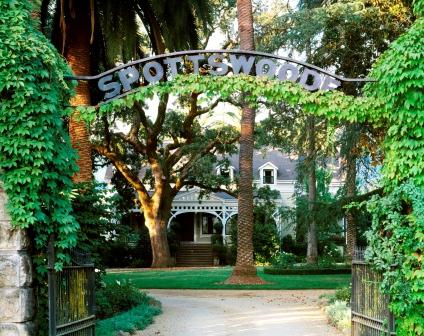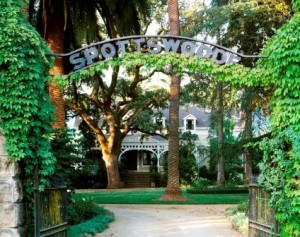2013 Spottswoode Sauvignon Blanc North Coast California USA Wine Tasting Note
5404 Views
|
2013
Spottswoode Sauvignon Blanc (North Coast)
Fresh, bright crisp, piquant grapefruit, lemon peel and rocky, tastes and textures show through here. Acidic, fresh and refreshing, the wine cuts a nice, straight path on your palate. 5,404 Views Tasted Nov 29, 2016 |


Everything about Spottswoode Vineyards, Napa Valley California Cabernet Sauvignon wine producer profile, wine tasting notes, wine and food pairing tips, best vintages, history of the property, information on their wine making techniques, terroir and soil. You can also read about the Grapes used for California wine and learn about the extensive History of Napa Valley, California Wines
Spottswoode History, Overview
Spottswoode is one of the older wineries in California. In fact, it dates all the way back to 1882, when George Schonewald purchased 31, prime acres in what is now known as the St. Helena appellation. At the time, George Schonewald's original intention was to use the property as a fun, summer vacation retreat for his family. Two years later, in 1884, Schonewald sold several acres to Frank Kraft. Frank Kraft knew this was prime land and he quickly started Kraft Family wines.
The original winery built by Kraft is still in use today. Currently, it serves as the wine cellar for the Spottswoode wines. The regal looking house on the Spottswoode property was built by George Schonewald, who modeled it after a hotel he was fond of, located in nearby Monterey California. In 1906, Joseph Bliss purchased the vineyards and winery from the Schonewald family Bliss changed the name of winery to Stonehurst. Joseph Bliss sold the estate just two years later to Dr. George Allen. George Allen eventually sold the property to the Spotts family. After taking possession of the estate they renamed the winery using their name and called it Spottswoode. That is how the state found its name.
The Spotts family planted the vineyard with the popular grape varieties of the day, Gamay, Zinfandel, Colombard and Sauvignon Blanc, along some vines devoted to Cabernet Sauvignon as well. The Spotts family sold the winery in 1972 to the Novak family who increased the size of the estate by purchasing 15 additional acres which enlarged the property to a total of 46 acres of vines.
At first, after the purchase by the Novak family, Spottswoode sold their harvest to other more established growers including Shafer and Duckhorn. In fact, it was due in part to encouragement from John Shafer that the Novak family began producing and bottling their own wine. In 1982, Spottswoode released their first vintages of Cabernet Sauvignon. They also hired Tony Soter as their wine consultant and began producing a string of consistently, high quality wines. One of the first changes that took place shortly after the arrival of Tony Soter in 1985 was moving to 100% organic farming techniques. In fact, Spottswoode was one of the first vineyards in Napa to begin farm using only organic methods.
In 2002, Spottswoode introduced a second wine to their estate Cabernet Sauvignon, Lyndenhurst. The name Lyndenhurst was inspired by one of the daughters of the daughter of the Novak family, Lindy. Lyndenhurst is produced from the estate's young vines. This introduction is a second wine is one of the key reasons for the increase in the Spottswoode Cabernet Sauvignon. Sadly, Mary Novak, the patriarch of the Novak family passed away, September 25, 2016. Mary Novak was 84 years old. Beth Novak Milliken remains in charge of Spottswoode today.
Spottswoode Vineyards, Wines, Winemaking
Spottswoode's vineyard is planted in sandy, clay, gravel and loam soils. Currently, they produce Cabernet Sauvignon and Sauvignon Blanc. Spottswoode is vinified in a combination of cement vats and stainless steel tanks. Malolactic fermentation takes place in barrel. The red wine of Spottswoode wine is aged for about 22 months in 65% new French oak barrels. The Sauvignon Blanc is aged in a combination of vessels, steel drums, concrete, egg shaped vats and French oak barrels. With 40 acres under vine, Spottswoode produces an average of 5,000 cases of wine per year.
Today, Spottswoode is on top of their game producing some of the best Cabernet Sauvignon wines in the Napa Valley.
Serving and Decanting Spottswoode with Wine, Food, Pairing Tips
Spottswoode wines are best served at 15.5 degrees Celsius, 60 degrees Fahrenheit. The cool, almost cellar temperature gives the wine more freshness and lift. Young vintages of their red wine can be decanted for 1-3 hours, depending on the character of the vintage. This allows the wine to soften and open its perfume. Older vintages might need very little decanting, just enough to remove the sediment.
The red wine of Spottswoode is best served with all types of classic meat dishes, veal, pork, beef, lamb, duck, game, roast chicken, ribs, hamburgers, barbecue, roasted, braised, grilled dishes and stews. Spottswoode is also good with Asian dishes, hearty fish courses like tuna, salmon, mushrooms and pasta.
The white wine of Spottswoode is best served with all types of seafood and shellfish, sushi, sashimi, chicken, veal, pork and cheese.

